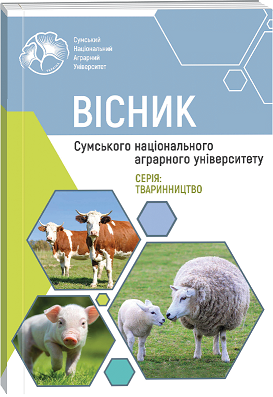THE EFFECT OF HIGH-TEMPERATURE MEAT PROCESSING TECHNOLOGY ON THE FLESH QUALITY OF BROILERS FED WITH ASTRAGALUS EXTRACT AND GLYCYRRHIZA EXTRACT
Abstract
This experiment was conducted to investigate the effects of high-temperature processing of meat raw materials technology on the flesh quality of broilers fed with Astragalus extract and Glycyrrhiza extract and their combination. Also at the same time, was investigated the effect of feeding, extracts of plant Astragalus extract and Glycyrrhiza extract were used to improve the quality and taste of meat of broiler chickens. Analysing influence of high-temperature processing of meat raw materials technology on the content of nutrients in chicken flesh it is necessary to note, that Compared with CON group, CP in AE group, GE group, AE+GE Ⅰ group and AE+GE Ⅱ group was significantly increased (P < 0.05). There were no significant differences in EE, Ash, Ca and P among all groups (P > 0.05). By this study, it was found that, compared with the control group, the crude protein content in the meat treated with Astragalus extract and Glycyrrhiza extract was significantly increased after high temperature treatment, indicating that Astragalus extract and Glycyrrhiza extract could improve the nutritional value of meat after high temperature treatment, and the effect was better than use the antibiotics.Also, high-temperature technology processing of meat raw materials had an effect on such an indicator as fatty acid content in chicken. Compared with CON group, PUFA content in AE group, GE group, AE+GE Ⅰ group and AE+GE Ⅱ group and MUFA content in AE+GE Ⅰ group and AE+GEⅡ group were significantly increased (P < 0.05). There was no significant difference in SFA content among all groups. It is also necessary to note the influence of technology high-temperature processing on processing of meat raw materials on such an indicator as flesh colour and shear force. Compared with CON group, a* in AE group, GE group, AE+GE Ⅰ group and AE+GE Ⅱ group was significantly increased, while b* and shear force were significantly decreased (P < 0.05). There was no significant difference in L value among all groups (P > 0.05). By this study, the L value of meat color in each group did not change significantly after high-temperature technology processing, but the a* value of meat color in the groups treated with Astragalus and Glycyrrhiza was significantly increased, and the b* value was significantly decreased, indicating that the consumption of Astragalus extract and Glycyrrhiza extract of high temperature treatment could improve the meat color after after such treatment. In summary, the following can be noted adding Astragalus extract and Glycyrrhiza extract, and their combination, can improve the meat quality and flavour of broilers.
References
2. BaÉza E. Harmonization of methodologies for the assessment of poultry meat quality features [J]. Worlds Poultry Science Journal, 2011,67(1):137–151.
3. Beriain, M. J., Horcada, A., Lizaso, G., & Purroy, A. Effect of baking on quality attributes of pig meat. Meat Science, 2011,89(4), 480–486.
4. Cui, Y., Wang, Q., Liu, S., & Sun, R. Plant extracts in poultry nutrition: A review. Journal of animal physiology and animal nutrition, 2019,103(1), 3–14.
5. Gao Tianli, Li Linqiang, Zhang Ting, et al. Effect of microwave and ultrasonic assisted treatment on preparation of fatty acids in Hengshan mutton. Meat Research, 2017,311) :7–12.
6. Jiang Xiuli, Cao Chuan-ai, Li Yue. Study on the correlation between Water distribution and quality of mixed minced meat with different drying time [J]. Food Science and Technology, 2017,(5):96–101.
7. Li Linqiang, Gao Tianli, Zhang LAN, et al. Effects of Frying, frying and Roasting on the quality of Hengshan Mutton [J]. Food and Machinery, 2016,32(9):17–21.
8. Liu Meng, Shi Zhijia, Gong Hui, et al. Effects of Natural Antioxidants on Fat Oxidation of Beef products with Different Hot Processing methods J. Meat Research, 2017.(12):17–22.
9. Liu Xiaozhan, Kong Yongchang, Li Dan. Advances in fat oxidation in meat and meat products Knife. Meat Industry, 2017.3) : 47–49.
10. Pastorino, G.; Cornara, L.; Soares, S.; Rodrigues, F.; Oliveira, M.B.P. Liquorice (Glycyrrhiza glabra): A phytochemical and pharmacological review. Phytother. Res. 2018, 32, 2323.
11. Song Jie, Hou Chengcheng, Yuan Youyun, et al. Study on Suitability of Different Parts of Mutton for roasting [J]. Food Science, 2017,38(15):108–114.
12. Sun Chengfeng, Zhou Nan, Zhu Liang, et al. Analysis of Free Fatty acid, free amino acid and nucleotide during processing of halogen pork [J]. Modern Food Science and Technology, 2016,(6):200–206.
13. Wang Ruihua, Wang Qian, Jiang Wanzhou, et al. Effects of cooking methods on lipid oxidation and fatty acid composition of pork intramuscular fat. Acta Food Sinica,2017,17(7):61–68.
14. Wang Xiangxiang, He Zhifei, Song Cui, et al. Changes of intramuscular fatty acid composition in Sichuan White Rabbits after different treatments during cold storage [J]. Food and Fermentation Industry, 2017,43(4):84–91.
15. Zhang LAN, Gao Tianli, Liu Yongfeng, et al. Effects of three traditional Chinese high temperature cooking techniques on the quality of beef food products. Food and Fermentation Industry, 2016,42(11):126–132.
16. Zheng, Y.; Ren, W.; Zhang, L.; Zhang, Y.; Liu, D.; Liu, Y. A review of the pharmacological action of Astragalus polysaccharide. Front. Pharmacol. 2020, 11, 349.
17. Zhou Guanghong, Li Chunbao, Xu Xinglian. Research progress of meat quality evaluation methods [J]. Chinese Journal of Science and Technology, 2007,2(2):75–82.

 ISSN
ISSN  ISSN
ISSN 



